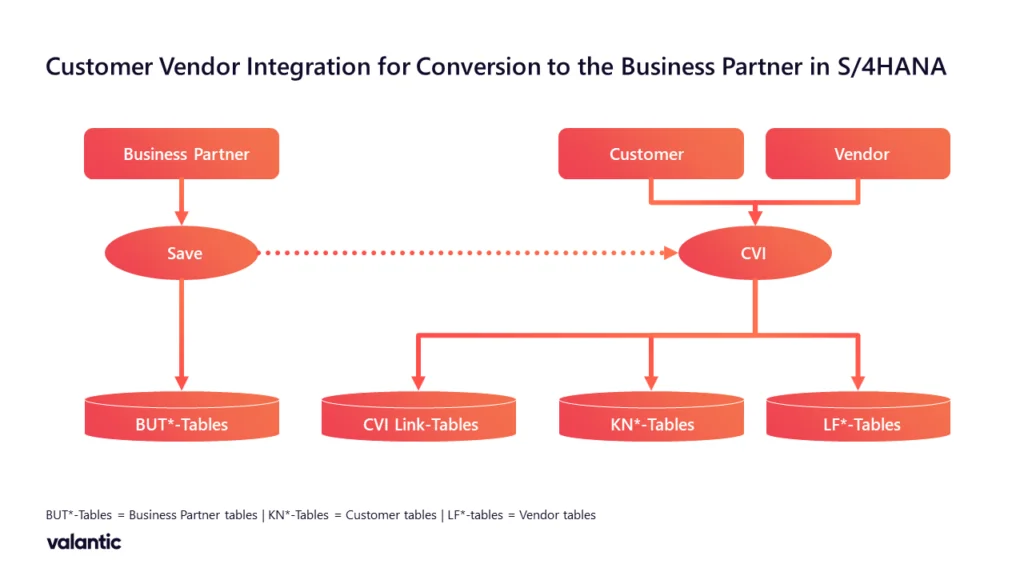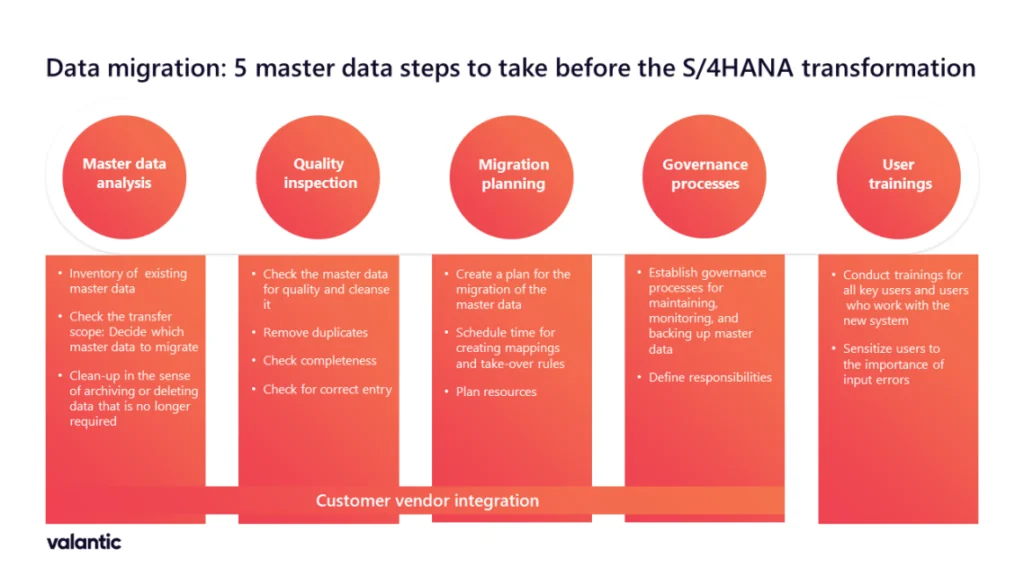Managing data migration: 5 master data steps to take for a successful S/4HANA transformation
October 10, 2023

October 10, 2023

SAP user companies must have migrated their systems to SAP S/4HANA by 2030 at the latest. That’s when the manufacturer’s support for legacy systems, such as SAP R3, SAP ERP, and SAP Business Suite will end. According to the current S/4HANA 2023 study by valantic, three-quarters of companies have not achieved this transformation yet. An important milestone is the migration of master data from existing SAP ERP systems or non-SAP systems to the new S/4HANA system. Data quality is a critical factor here. If the data quality is not good, a company cannot exploit the potential of S/4HANA for digital business processes. To ensure a smooth migration and seamless integration of master data into the new business processes, users should prepare this process as well as they can.
Master data is basic information about an organization’s operationally relevant objects that remains constant over a period of time. Such objects include customers, suppliers, products, employees, and business partners. This data is the basis for all internal business and technical business processes. Its quality therefore has a direct impact on numerous processes, such as planning, procurement, production, sales, and billing. Incomplete or incorrect master data can cause delays and errors in these processes.
Correct and consistent master data ensures efficient business processes and reduces costs. In addition, this data reduces the risk of making incorrect decisions and it increases customer satisfaction, for example by ensuring that contact is made with the right people at business partners or by storing up-to-date product information in the system. The correct and complete management of master data is therefore an important factor for a business’s success. It is therefore worth paying greater attention to master data within the scope of an SAP S/4HANA project.
An important step that must be taken with every S/4HANA conversion is customer vendor integration (CVI). The CVI is necessary to integrate the existing customer and supplier data into the business partner. Depending on the project approach, this can be done before migration in the source system or during migration in the target system. The CVI ensures that when business partners are created and changed, the corresponding customer and supplier tables are updated automatically (see figure).

The following five steps will help organizations prepare for data migration and set this process on the right path.
1. Perform master data analysis
First, companies should carefully review their master data to determine which master data needs to be migrated to the new system. Data that is no longer needed takes up time and money unnecessarily and can be archived. Data cleansing is never easier and less expensive. Migration is thus the opportunity to free the company from unnecessary data.
2. Check and clean up data for quality
The next step is to subject the master data to a quality check. This includes, for example, correcting errors and deleting duplicates. Companies should also check whether the master data is complete, up-to-date, and has been entered correctly. It may be useful to standardize specific master data fields to improve data consistency across all systems and processes in use. Tools based on standard queries can help with these tasks.
3. Plan data migration
After cleansing, the master data must be migrated to the new system. Experience proves that it’s a good idea to create a detailed plan for data migration. It’s crucial that all necessary data is migrated and imported into the right system fields correctly and completely. Accordingly, sufficient time must be planned for the creation of mappings, derivations, and transfer rules. Sufficient human resources should also be available for this process, not just in the master data team since many steps must be planned and implemented in an integrative manner.
4. Define governance processes for master data management
Companies should define governance processes to maintain, monitor, and secure their master data. This includes clear responsibilities and responsibilities for master data management and transparency concerning these processes for all employees. Data quality remains consistently high even after the migration due to uniform control processes across the company. This lays the foundation for continuous and efficient master data management.
5. Conduct trainings
Finally, companies should train all employees who handle master data and its processing adequately and sensitize them to the importance of master data processes. This ensures that all users know how to work with the master data in the new system and what impact their decisions can have on master data and business processes.

These steps will help companies ensure that their master data is well prepared and can be integrated seamlessly into the new system. This also ensures a more successful S/4HANA project and companies can benefit more quickly from the numerous advantages of the new system.
valantic will be happy to advise you on all topics relating to master data and its migration – from the definition of requirements and the design of your data migration to the implementation of your future master data organization. We take the necessary measures to improve data quality and set up the necessary systems and processes for you.
We realize your data migration within the planned time frame and with the shortest possible downtime.
MDM Master Data Management & Data Migration
Are you planning an SAP S/4HANA implementation and need support with data migration and the associated master data processes? We will be happy to advise you without obligation.
Don't miss a thing.
Subscribe to our latest blog articles.